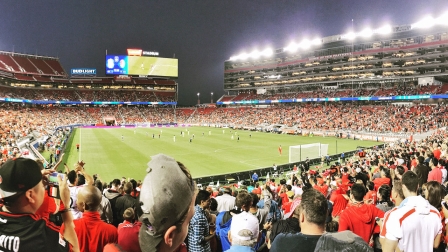Major League Soccer Is Perfecting The “Beautiful Game” For The Social Age
Last week in San Jose, the great and the good of brands who activate in U.S. soccer gathered in the name of a single game. At the 2016 Major League Soccer All-Star Game, from ESPN to Adidas, brands, broadcasters, and Major League Soccer clubs mixed together for a week to celebrate the continued rise of soccer in America.
Each year, the MLS All-Star Game pits a selection of the best Major League Soccer players against a high-profile club from overseas. Billed as the battle between north London and North America, this year’s game brought over Arsenal of the Premier League, but the game has become almost incidental now to the hive of activity and incredible buildup created to heighten overall awareness and excitement around soccer in North America.
But this isn’t some naive marketing exercise for an audience who are less knowledgeable about the sport. On the contrary, what we saw was a refreshingly innovative, transparent, fun approach to brand, talent, marketing, and sporting occasion, from which the U.K. in particular should sit up and take note.
From the moment you landed, the excitement was palpable from San Jose through Silicon Valley, up to San Francisco and beyond. People know it’s a big event, previewed on local and national news, and the game is rightly a source of pride. It reflects an incredible rising tide of soccer in the U.S., a game being played at grassroots level where school children are choosing to kick a ball rather than whacking one with a baseball bat, or hurling themselves into tackles wearing body armour. The unanswered rise of the game here is pleasingly mirrored by brands and marketers not resorting to old tactics and techniques.
Nothing epitomizes this more than the team selection in the game itself. Fans get a significant say in who is picked, and who plays. The favorites of Major League Soccer are subsequently thrown together in a kind of crowdsourced dream team. That’s not all, as the mechanics of selection involved the hottest platforms right now. First up was Snapchat. You simply send in your vote by submitting a snap of your chosen player for each position. What a wondrous, engaging, and rich manner to get involved with an exhibition game. None of your cynicism here, or tried-and-tested techniques refusing to interrupt the status quo. On the contrary, leveraging the most authentic platform on the planet right now feels absolutely on the money for keen fans and users alike. Secondly, the 11th player on the roster was determined by an AT&T/EA Sports “More Than a Vote” challenge. A player received a vote every time a fan scored while playing FIFA 16 using a striker from the MLS All-Star Ballot. The striker with the most goals could earn a place on the actual all-star team. NYCFC striker David Villa took that spot, as fans scored more than 800,000 goals with him in the video game.
This is such exciting work from AT&T and EA Sports. There is a young audience who simply mix and match their language, terms, and vernacular between games like FIFA and Football Manager, and the real-life action. They do not see the joins or divisions like us older crowd once did, and don’t refer to being online simply because they’re never offline. Subsequently, to merge the formats of real-life team selection and that of playing as part of a game of FIFA, is a brilliant blurring of lines that are already unclear. EA Sports pride themselves on a game predicated perfectly on real, accurate statistics, so the more it feels like real life, the better. To even have an impact on the actual action you watch is therefore a fantastic achievement, and one we all should be applauding. I would be surprised if we saw anything like this level of smart innovation around the game in Europe right now, where too much red tape and reliance on the past would prevent such quality thinking and activation.
From this team selection innovation, the MLS also approached the event with something of a marketing masterclass. Daily emails, text alerts, and notifications took you through a dizzying array of events held to promote the game itself, and Major League Soccer overall. Particularly encouraging was the focus on youth, with one of the largest stadiums around holding a game for effectively the teams’ youth product, yet in front of predictably packed crowds. This particular element taps into a fascinating U.S. obsession with college football and beyond, where the youthful exuberance is embraced and hundreds of thousands attend their local college sports. What is smart, is that the best of this sentiment is leveraged here, yet repositioned so more familiar with football (soccer) fans.

One brand that got it very right at MLS All-Star was Adidas. The brand’s “first never follows” motif felt particularly appropriate for these guys who arrived in force but with a focus on youth and creating moments wherever they could. On Friday, July 29, the brand released the All-Star team’s shirt, which would be worn against Arsenal, by leveraging a photo shoot with Soccer Bible, building in influencer media to help establish immediate credibility into the launch. The brand then ramped things up by holding an Elite Soccer Performance (ESP) match featuring the top MLS academy players around the country, as well as an international academy team. It was a typically smart and assured role for a confident brand, able to mix and match superstar involvement with a constant promotion of the youth product, too.
Soccer in this region can often throw off the shackles of tradition, which can hold back its innovation in other places, like in the U.K. Top talent for example is everywhere, from presenters to pitch-side pundits, and even players absolutely willing to engage and be a part of the footy fiesta. Access to all areas doesn’t seem just for the privileged few, but instead a mantra for encouraging everyone to get up close and personal. From one-off live TV specials, to kids’ football academies, and even incredibly controlled signing sessions in the hotel where players take their time to mingle with fans—the whole feel is of a refreshingly open, modern, branded event, which is perfectly reflecting the modern attitude with which the game is being run.
This is an age after all where Twitter has enabled fans to speak directly with their stars, and where selfies have replaced the arms-length technique of an autograph. It is all about immediacy and authenticity, and the MLS All-Star game has managed to marry the demands and appetite of a modern consumer with a new way of showing off the world’s most popular sport. They have figured out how to propel the game forward for fans, while shrewdly bringing brands into the mix as well.

The freshness of this event feels in direct contradiction to how brands engage with football and its fans elsewhere. In the U.K. for example, so bound by the red-tape rules of the past, image rights, or broadcaster privileges, this level of inventive involvement is rare. The fans alone are providing the continual push of innovation through their leverage of smart technology and an empowered stance. Subsequently, it is a fan who holds aloft Periscope at Glasgow’s Ibrox Stadium, and has more people watching his stream than are in the stadium at the Edinburgh Derby. It is the fans who watch recreated illustrative goal animations like we crafted at Copa90 over 6 million times during the tournament, exceeding most viewing audiences of live on-air matches. The fans drive the freshness of approach to the game in the historic home of soccer, but it is admirable how much innovation is pushed directly from MLS at this most vital of events.
Baseball in the States, like cricket in the U.K., was arguably made for the radio era—full of long-winded statistics and played at a much slower pace with only the occasional rush of real drama. The NFL was built for TV, complete with compartmentalized and quartered action enabling high-spending advertising to act as a divider between the action. So soccer feels built for this digital and social age, where moments are everything, and instantaneous on-pitch memories are captured, documented, and spread around the world at the speed of a meme.
The MLS All-Star Game is proving that there is a rich methodology to engage with even the most dyed-in-the-wool sport, which captures imagination, leverages the young, and brings top talent closer to the fans. The game will be all the better for it, on both sides of the Atlantic.
James Kirkham is the head of global football network Copa90, and chief strategy officer for Bigballs Media.
Fast Company , Read Full Story
(25)













